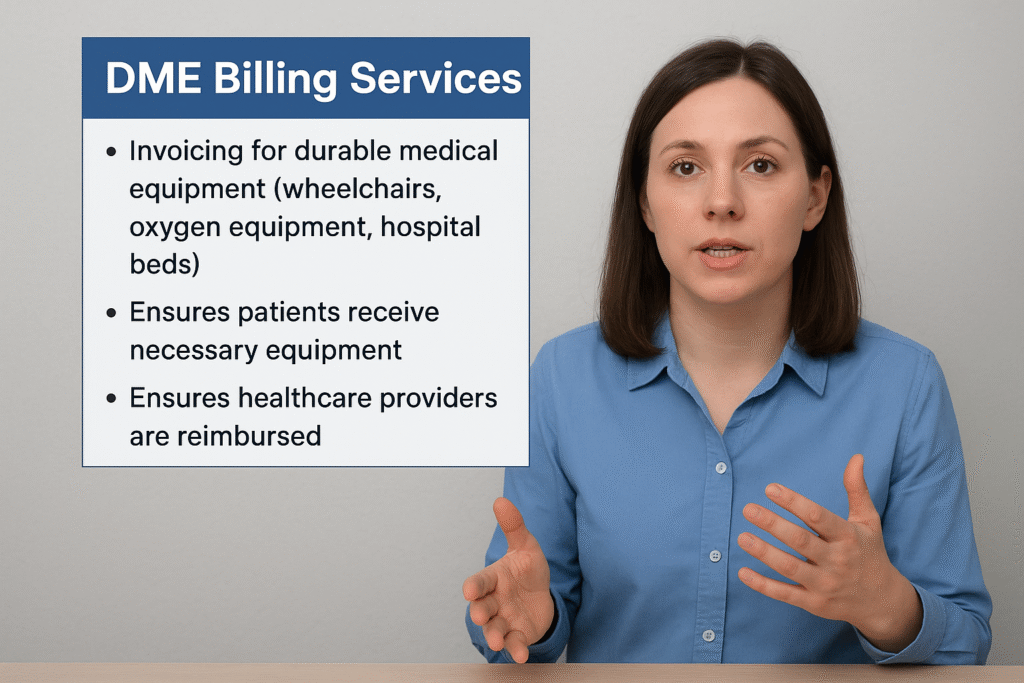Durable Medical Equipment (DME) plays a vital role in patient care by supporting recovery and enhancing quality of life. However, ensuring timely reimbursement for these devices requires a specialized approach to medical billing. DME Billing Services streamline the process, reduce errors, and help healthcare providers maintain financial stability. This article explores what DME billing is, its importance, tips to minimize claim errors, the types of equipment covered, common challenges, and best practices to optimize reimbursement.
What is DME Billing and Why is it Important?
DME billing refers to the process of submitting claims for reimbursement of durable medical equipment, such as wheelchairs, oxygen supplies, and prosthetics, that are prescribed by physicians. Since these items are essential for long-term use, insurance companies and Medicare have specific regulations governing their coverage.
The importance of accurate DME billing cannot be overstated:
- Patient Care Continuity – Patients depend on these devices for daily living and recovery. A billing delay may mean a delay in receiving essential equipment.
- Compliance with Insurance Rules – Payers have strict requirements for documentation, coding, and claim submission. Proper billing ensures compliance with these regulations.
- Revenue Cycle Optimization – Errors in billing lead to claim denials, delayed payments, and financial instability for healthcare providers.
- Operational Efficiency – Outsourcing or streamlining DME Billing Services saves administrative staff valuable time, allowing them to focus on patient care rather than paperwork.
In short, DME billing bridges the gap between providers, insurers, and patients—ensuring that medical equipment is both accessible and reimbursed correctly.
Looking to improve your practice’s billing efficiency? Understanding key billing principles
Tips on Maximizing Claim Accuracy and Reducing Errors
One of the biggest challenges in medical billing lies in avoiding costly mistakes. Errors lead to rejected or denied claims, resulting in wasted resources and delayed payments. Below are some tips to maximize accuracy:
1. Verify Patient Eligibility
Before providing equipment, verify insurance coverage and eligibility. This step prevents claim denials caused by non-coverage or expired policies.
2. Accurate Documentation
Ensure that physician notes, prescriptions, and medical necessity documentation are complete and signed. Missing paperwork is a common reason for claim rejection.
3. Use Correct HCPCS Codes
Durable medical equipment is billed using Healthcare Common Procedure Coding System (HCPCS) codes. Proper coding is critical for approval and reimbursement.

4. Stay Updated on Payer Guidelines
Insurance providers and Medicare frequently update policies. Billing staff must stay current with these changes to avoid compliance issues.
5. Monitor Claim Status Regularly
Tracking claim status helps in quickly identifying denials or rejections. Prompt follow-ups lead to faster resolution.
6. Invest in Staff Training and Billing Software
Billing software and trained professionals minimize manual errors and streamline claim processing.
Types of Equipment Covered Under DME
Durable Medical Equipment includes a wide range of items prescribed for long-term use. These devices improve patient mobility, respiratory function, and overall health outcomes. Common examples include:
- Mobility Aids – Wheelchairs, walkers, and crutches that support movement.
- Respiratory Equipment – Oxygen concentrators, nebulizers, and CPAP machines.
- Orthopedic Supports – Braces, splints, and prosthetic devices.
- Hospital Beds and Accessories – Adjustable beds, mattresses, and bedside rails.
- Monitoring Devices – Blood glucose monitors and infusion pumps.
- Other Essential Supplies – Feeding tubes, traction equipment, and compression devices.
Each item must be prescribed by a physician and supported with documentation of medical necessity before billing.
Common Challenges in DME Billing
While DME is crucial for patient care, billing for it comes with unique challenges. These hurdles often result in delayed payments or denied claims.
1. Complex Documentation Requirements
Insurance companies demand detailed medical necessity documents. Missing information can easily trigger denials.
2. Frequent Policy Changes
Medicare and private payers regularly update guidelines, making compliance a moving target.
3. High Claim Denial Rates
Due to strict coding and documentation rules, DME claims face higher denial rates compared to other medical services.

4. Pre-Authorization Issues
Many DME items require prior authorization. Failure to secure approval results in unpaid claims.
5. Patient Cost Responsibility
Patients may be unaware of their out-of-pocket costs, leading to disputes or non-payment.
6. Time-Intensive Process
The administrative burden of preparing, submitting, and resubmitting claims can overwhelm healthcare staff.
Table: Quick Guide to DME Billing Essentials
| Key Factor | Quick Note |
|---|---|
| Eligibility Check | Verify insurance coverage |
| Documentation | Ensure medical necessity |
| Coding Accuracy | Use correct HCPCS codes |
| Authorization | Obtain pre-approval |
| Claim Tracking | Monitor status regularly |
| Staff Training | Ongoing updates required |
Best Practices for Successful DME Billing
To overcome challenges and streamline billing operations, healthcare providers should adopt best practices that ensure accuracy and efficiency.
Standardize Processes
Establish a structured workflow for claim submission, from eligibility checks to payment posting.
Outsource to Professionals
Many providers partner with specialized DME Billing Services companies to handle compliance, reduce denials, and improve revenue cycle management.
Automate Where Possible
Leverage billing software for coding assistance, claim submission, and denial management.
Conduct Regular Audits
Internal audits help identify recurring mistakes and compliance risks, allowing for timely corrections.
Find out how DME Billing Services support healthcare providers with accurate coding.
Educate Patients
Clear communication about coverage, documentation needs, and out-of-pocket costs reduces disputes later.
Why Choose Professional DME Billing Services?
Outsourcing DME billing to experts brings several advantages:
- Reduced Administrative Burden – Frees up in-house staff for patient care.
- Faster Reimbursements – Experts know payer requirements and minimize delays.
- Error Reduction – Trained professionals ensure accurate coding and compliance.
- Scalability – As patient volume grows, outsourced billing can expand without strain.
By partnering with professional billing providers, healthcare organizations can focus more on patient outcomes while maintaining strong financial health.
Conclusion
Durable Medical Equipment is a lifeline for countless patients, but receiving timely reimbursement requires navigating a complex billing landscape. With the right strategies—such as proper documentation, coding accuracy, and partnering with professional DME Billing Services healthcare providers can minimize denials, maximize revenue, and ensure patients receive the equipment they need without delays.
FAQs
Which items are commonly billed under DME?
Common DME items include mobility aids (wheelchairs, crutches), respiratory devices (oxygen concentrators, CPAP machines), orthopedic supports, hospital beds, and monitoring devices like glucose monitors.
How can claim errors be minimized in DME billing?
Errors can be reduced by verifying patient eligibility, maintaining accurate documentation, using the right codes, obtaining pre-authorization, and tracking claim status regularly.
Who benefits from professional DME Billing Services?
Both patients and healthcare providers benefit. Patients receive timely equipment without delays, while providers improve cash flow, reduce denials, and stay compliant with payer guidelines.

